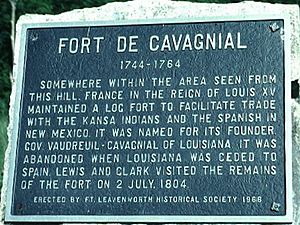Fort de Cavagnial facts for kids
Quick facts for kids Fort de Cavagnial |
|
|---|---|
| north of Fort Leavenworth, Kansas | |
 |
|
| Type | Fort |
| Site information | |
| Controlled by | New France; Spain |
| Site history | |
| Built | 1744 |
| In use | 1744-1764 |
| Garrison information | |
| Past commanders |
François Coulon de Villiers (c.1746–1750) Augustin-Antoine de la Barre (1750–1751) Louis Robineau de Portneuf (1751– c. 1754) Jean Francois Tisserant de Moncharvaux (c.1754–c. 1758) |
Fort de Cavagnial (also known as Fort Cavagnolle or Fort Cavagnal) was a French fort and trading post. It was built on the west side of the Missouri River. This was somewhere north of Kansas City, Kansas, and Fort Leavenworth, Kansas. The fort was active from 1744 until about 1764.
When Meriwether Lewis and William Clark explored the area in 1804, they saw some ruins of the fort. But by the mid-1800s, all signs of the fort were gone. Today, no one knows the exact spot where Fort de Cavagnial once stood. It remains a historical mystery!
Contents
The Story of Fort de Cavagnial
Building and Using the Fort
The fort was named after the Governor of Louisiana, Marquis de Vaudreuil-Cavagnial. At the time, it was the westernmost French fort on the Missouri River.
Its first leader was François Coulon de Villiers. He came from a famous military family in New France. Like many forts on the frontier, it was also a trading post. A man named Joseph Athanase Trottier dit Desruisseaux ran the trading post. He had special permission to control all trade on the Missouri River from 1745 to 1750.
Deruisseau chose this spot because the local Kansa tribe were friendly. They also provided good quality furs for trade. The location was also very important for controlling the area.
The Kansas Historical Society described the fort as:
- small but strong
- surrounded by a fence of thick logs
- with guard towers at each of the four corners
- inside, there was a house for the leader
- a guardhouse for soldiers
- a place to store gunpowder
- a house for the trader
- and a house for the trader's workers
- Most buildings were made of logs and covered with mud.
Why the Fort Disappeared
Fort de Cavagnial started to decline after the French and Indian War (1754–1763). During this war, the area around the fort came under the control of Spain.
Even though Spain took control, French soldiers stayed at the fort until 1764. Then, an order came to "throw down" the outpost. This meant the soldiers had to tear down the fort and go back to New Orleans.
The fort was not completely destroyed, though. In 1804, Meriwether Lewis and William Clark found the old site. They wrote in their journal that they could see "some remains of chimneys." They also noted the general shape of the fort and a good spring for water.
In 1819, other explorers also saw the ruins. But by the mid-1800s, all traces of Fort de Cavagnial were gone.
Where Was Fort de Cavagnial?
The exact location of the fort is still a mystery. This is because old reports about its trade with the Kansa tribe are different.
Some old British reports said it was below the point where the Kansas River and Missouri River meet. This area is now part of Kansas City. However, most reports say it was on the bluffs above Salt Creek. This creek flows into the Missouri River just north of modern-day Fort Leavenworth. This was also near a large Kansa village.
Lewis and Clark visited this area on July 2, 1804. They wrote about the site:
- The French used to have a fort here. It was built to protect trade with this nation. The spot looks very good for a town. The valley is rich and wide. A small stream winds through it. One part of the river bank still offers a good place for boats to land.
For many years, researchers and archaeologists have searched for the fort. They have flown over the area in helicopters. They have studied aerial photos and walked over almost every part of the land. But they have not found any clear signs of the fort.
In 1987, a magazine called Soldiers said that David L. Campbell might have found foundations. These foundations were on a bluff and could have been the fort's remains. This idea was also mentioned in The Leavenworth Times in 2012. However, archaeologists have not yet confirmed this finding.
In 2004, the Kansas Historical Society said that the fort's exact location "remains one of the active historical and archeological mysteries in Kansas."

